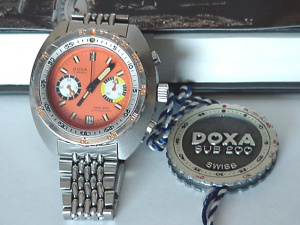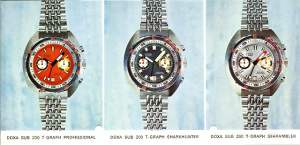Doxa Sub 200 T-Graph: Difference between revisions
Created page with "==The Doxa Sub 200 T-Graph== thumb The chronograph version of the Doxa 300. Produced in three color variations (Orange, Black, Silver, similar to the Sub..." |
|||
| (5 intermediate revisions by the same user not shown) | |||
| Line 1: | Line 1: | ||
[[File:Doxa 200t.jpg|thumb]] | |||
==The Doxa Sub 200 T-Graph== | ==The Doxa Sub 200 T-Graph== | ||
[[File:Doxa200t.jpg|thumb]] | [[File:Doxa200t.jpg|thumb]] | ||
The chronograph version of the Doxa 300. Produced in three color variations (Orange, Black, Silver, similar to the Sub 300), this chronograph had a thicker case and a bigger caliber. The cal.287 by Doxa | The chronograph version of the [[Doxa 300]]. Produced in three color variations (Orange, Black, Silver, similar to the Sub 300), this chronograph had a thicker case and a bigger caliber.Although the SUB 200 T.Graph was produced in Professional, Sharkhunter and Searambler versions, it is not known exactly how many were made. However, the number is believed to be in hundreds rather than thousands. The 200 T.GRAPH Chronograph was produced during Doxa's Synchron days. | ||
==Movement== | |||
The cal.287 based on Eberhard cal.310-82 | |||
The movement labeled "Cal. 287" by Doxa is based on the very high grade EBERHARD Cal. 310-82. It is a 14 (lignes) movement that was produced "in-house" by The Eberhard Watch Co. and it is a rather special movement. It is one of the most sturdy chronograph movements ever produced and has all the features of a classic chrono movement. It uses a column-wheel to co-ordinate the chronograph-functions instead of the cheaper "Shuttle-Cam" mechanism. It is believed to be the very last original design of the 60s/70s era to utilise a column-wheel. The Eberhard 310 was the base-movement and the 310-82 is the version with the date-ring. In 1969 when Doxa first introduced the "T.Graph" series there were not many movements to choose from and even less that incorporated the date-function as well. Valjoux had one to offer (used by [[Heuer]] to produce the world's first chronograph to include a date-feature) and the Lemania/Omega 930 was the other alternative. And of course there was the Eberhard 310-82. It seems that Eberhard (or the company that owned Eberhard back then) so this provides a credible explanation as to why Doxa chose the Eberhard movement to power the T.Graph. The quality of the Eberhard 310-82 is of an extremely high standard and is directly comparable to the Lemania/Omega 930. | |||
==Links== | |||
*[[Switzerland]] | |||
*[[Doxa]] | |||
*[[Doxa 300]] | |||
*[[The Watches of Jacques Cousteau]] | |||
*[[Diving Watches]] | |||
*[[Main Page]] | |||
Credits - https://doxa300t.woopdeedoo.com/200t/dave200t.htm | |||
Latest revision as of 16:02, 4 May 2020

The Doxa Sub 200 T-Graph

The chronograph version of the Doxa 300. Produced in three color variations (Orange, Black, Silver, similar to the Sub 300), this chronograph had a thicker case and a bigger caliber.Although the SUB 200 T.Graph was produced in Professional, Sharkhunter and Searambler versions, it is not known exactly how many were made. However, the number is believed to be in hundreds rather than thousands. The 200 T.GRAPH Chronograph was produced during Doxa's Synchron days.
Movement
The cal.287 based on Eberhard cal.310-82
The movement labeled "Cal. 287" by Doxa is based on the very high grade EBERHARD Cal. 310-82. It is a 14 (lignes) movement that was produced "in-house" by The Eberhard Watch Co. and it is a rather special movement. It is one of the most sturdy chronograph movements ever produced and has all the features of a classic chrono movement. It uses a column-wheel to co-ordinate the chronograph-functions instead of the cheaper "Shuttle-Cam" mechanism. It is believed to be the very last original design of the 60s/70s era to utilise a column-wheel. The Eberhard 310 was the base-movement and the 310-82 is the version with the date-ring. In 1969 when Doxa first introduced the "T.Graph" series there were not many movements to choose from and even less that incorporated the date-function as well. Valjoux had one to offer (used by Heuer to produce the world's first chronograph to include a date-feature) and the Lemania/Omega 930 was the other alternative. And of course there was the Eberhard 310-82. It seems that Eberhard (or the company that owned Eberhard back then) so this provides a credible explanation as to why Doxa chose the Eberhard movement to power the T.Graph. The quality of the Eberhard 310-82 is of an extremely high standard and is directly comparable to the Lemania/Omega 930.
